Class 7 Geography Chapter 5 Notes - Water
| Table of contents |

|
| Water Cycle |

|
| Distribution of Water Bodies |

|
| Ocean Circulation |

|
| 1. Waves |

|
| 2. Tides |

|
| 3. Ocean Currents |

|
Water is all around us, from the flowing streams in forests to the raindrops that tap on our windows. Have you ever wondered where all this water comes from and where it goes?
Water is an essential resource that covers about three-fourths of the Earth’s surface, existing in various forms such as rivers, lakes, oceans, glaciers, and even water vapor in the atmosphere. Despite its abundance, only a small percentage of water is available as freshwater suitable for human use.
Water Cycle
The water cycle is a continuous process where water changes its form and circulates between the oceans, atmosphere, and land. Here’s how it works: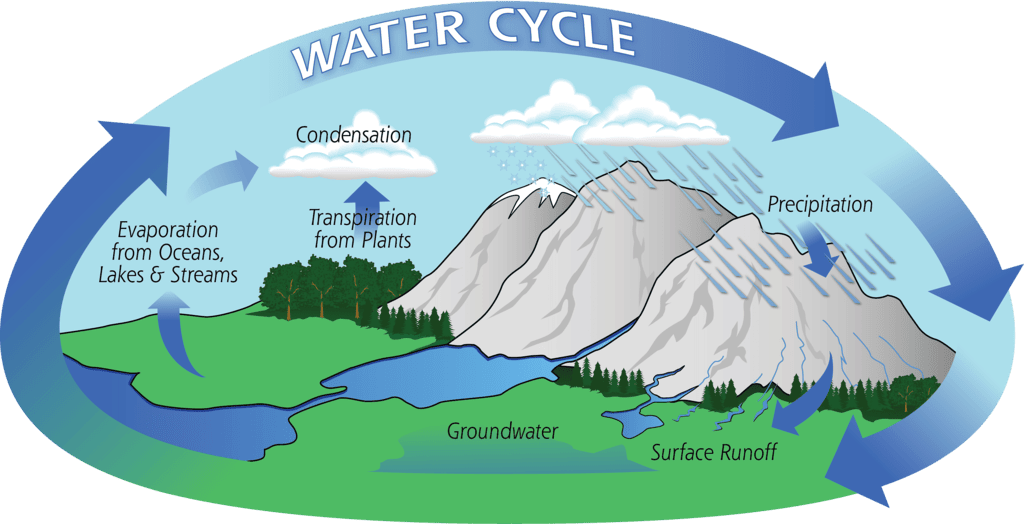 Water cycle
Water cycle
- Evaporation: The sun’s heat causes water from rivers, lakes, and oceans to evaporate, turning it into water vapor.
- Condensation: As the water vapor rises and cools, it condenses to form clouds.
- Precipitation: Water falls from clouds as rain, snow, or sleet, returning to the ground or sea.
- Runoff: The water then flows back into rivers, lakes, and oceans, completing the cycle.
Our planet works like a giant terrarium, where the same water has been cycling for centuries. The water that waters crops today might have traveled down the Amazon River a hundred years ago.
Note: A terrarium is a miniature, enclosed ecosystem designed to mimic a natural environment. You can create your own by filling a jar with soil and plants and closing it. The water that evaporates from the leaves and soil will condense and fall back, just like in the water cycle.
Terrarium
Distribution of Water Bodies
Freshwater mainly comes from rivers, ponds, springs, and glaciers. However, the water in oceans and seas is salty. Oceans have a lot of dissolved salts, mostly sodium chloride, which is the same as the salt you use in your food.
- About three-fourths of the earth’s surface is covered by water. These numbers are expected to increase, exacerbated by climate change and population growth (WMO).
- The following table gives the distribution of water in percentage:
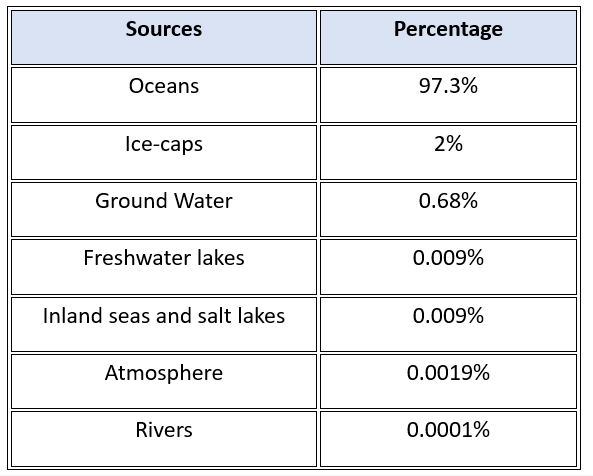
Important Fact:
About two billion people worldwide don’t have access to safe drinking water today (SDG Report 2022), and roughly half of the world’s population is experiencing severe water scarcity for at least part of the year (IPCC). These numbers are expected to increase, exacerbated by climate change and population growth (WMO).
Ocean Circulation
Walking barefoot on the seashore feels like magic. The wet sand, the cool breeze, the seabirds, the salty smell, and the sound of the waves are all amazing. Unlike ponds and lakes, the ocean water is always in motion. It never stays still. The movements in the ocean can be divided into waves, tides, and currents. 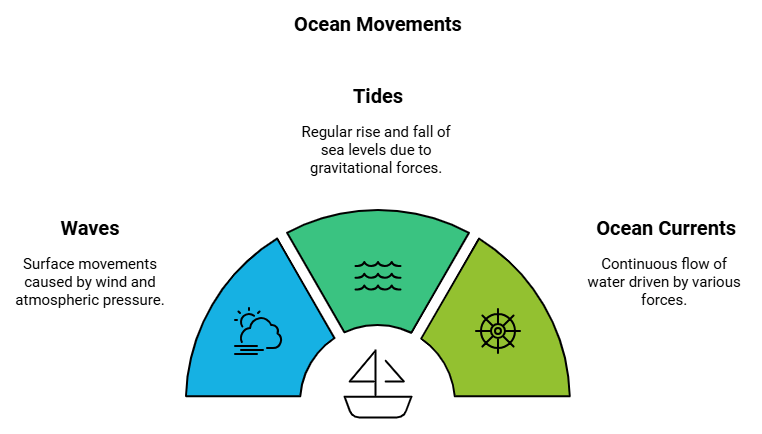
The movements that occur in oceans are of three types
- Waves
- Tides
- Ocean currents
1. Waves
- When playing throw ball on the beach, waves often push the ball back to shore if it lands in the water.
- Waves are created when winds scrape across the ocean's surface, causing the water to rise and fall.
- The stronger the wind, the larger the waves become.
Important Fact:
The term "tsunami" is a Japanese word that means "harbour waves," as harbors often get destroyed during these events.
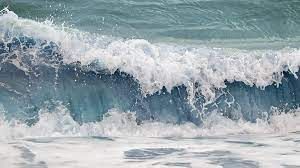 Ocean Waves
Ocean Waves
Strong winds during storms can generate massive waves that may cause significant destruction.
Natural events such as earthquakes, volcanic eruptions, or underwater landslides can displace large amounts of ocean water, creating tsunamis.
- Tsunamis can reach heights over 15 meters and travel at speeds exceeding 700 kilometers per hour.
- The largest recorded tsunami was 150 meters high.
- The 2004 tsunami caused widespread damage along India's coastlines and submerged the Indira Point in the Andaman and Nicobar Islands.
2. Tides
Tides are the rise and fall of ocean water that occurs twice a day.
- High tide covers much of the shore.
- Low tide occurs when the water recedes.
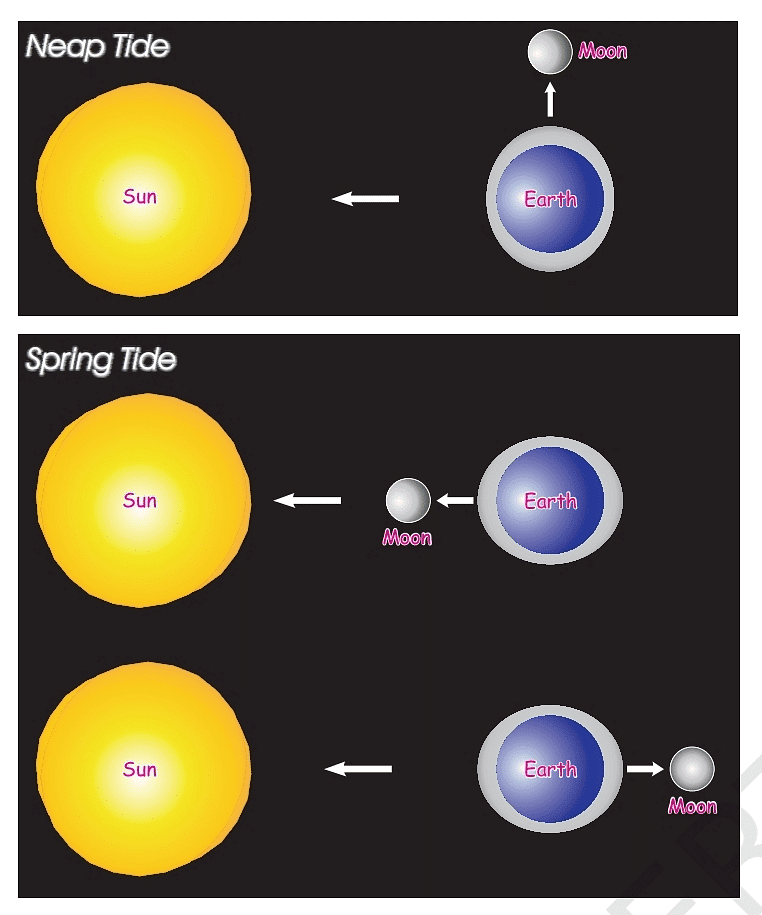 Neap and Spring Tides
Neap and Spring Tides
Tides are caused by the gravitational pull of the moon and the sun on Earth's surface.
- High tides occur when the moon's gravitational force pulls water closer to it.
- Spring tides (the highest tides) occur during the full moon and new moon phases when the sun, moon, and Earth are aligned.
- Neap tides (lower tides) occur during the first and last quarters of the moon when the gravitational forces of the sun and moon oppose each other.
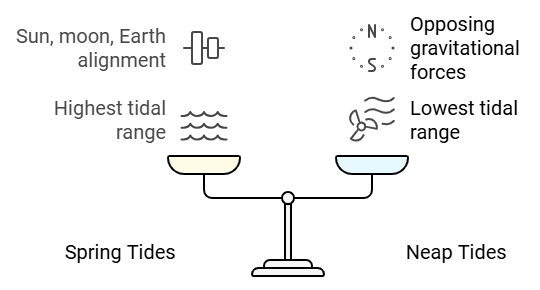
Significance of Tides:
- Tides aid in navigation by raising water levels near shores, making it easier for ships to access harbors.
- High tides bring more fish closer to shore, benefiting fishing activities.
- In some regions, the energy from tidal movements is harnessed to generate electricity.
3. Ocean Currents
Ocean currents are continuous flows of seawater that move across the ocean's surface in specific directions, similar to rivers within the sea.
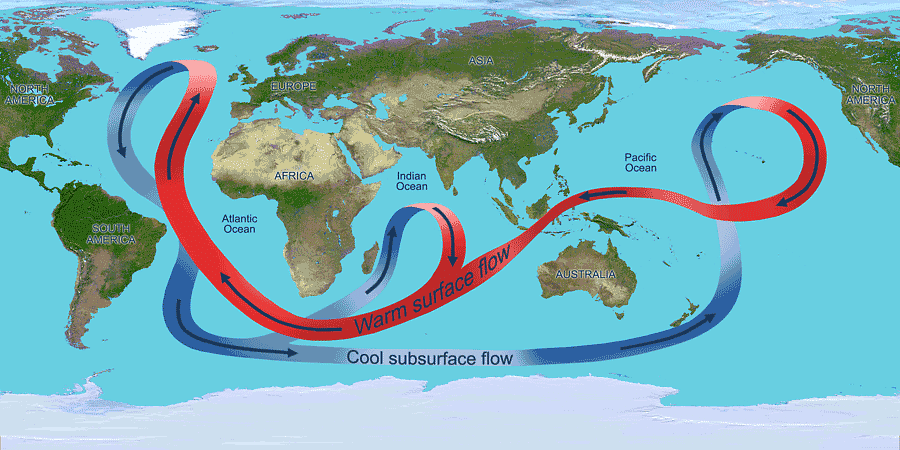 Warm and Cold Ocean Current
Warm and Cold Ocean Current
Warm and Cold Ocean Currents:
- Warm currents originate near the equator and flow toward the poles, carrying warm water over long distances.
- Cold currents transport water from polar or higher latitudes toward tropical or lower latitudes, cooling the regions they pass.
- Example: The Labrador Ocean Current (cold) flows southward from the Arctic.
- Example: The Gulf Stream (warm) flows northward along the eastern coast of North America.
Impact of Ocean Currents:
- Warm currents can warm coastal climates, while cold currents cool nearby lands.
- Regions where warm and cold currents converge are rich in marine life, creating prime fishing grounds (e.g., seas around Japan and the eastern coast of North America).
- The meeting of warm and cold currents can create foggy weather, posing challenges for navigation and maritime activities.
|
63 videos|552 docs|46 tests
|
FAQs on Class 7 Geography Chapter 5 Notes - Water
| 1. What is the water cycle and why is it important? |  |
| 2. How are water bodies distributed on Earth? |  |
| 3. What causes ocean waves? |  |
| 4. What are tides and how do they occur? |  |
| 5. What are ocean currents and why are they significant? |  |
















